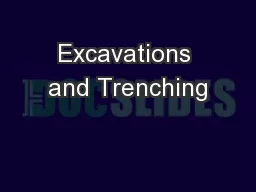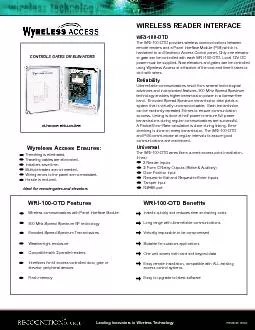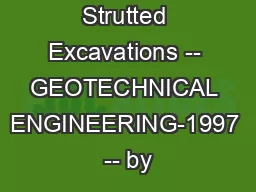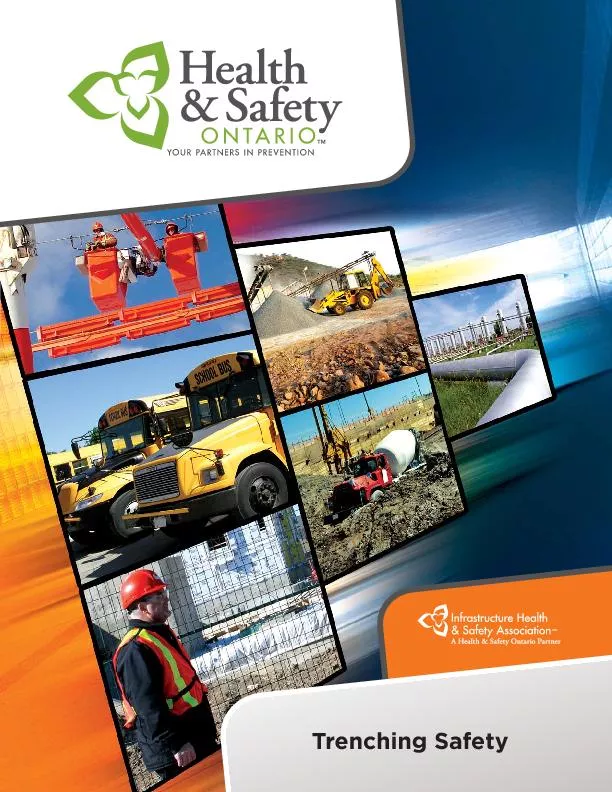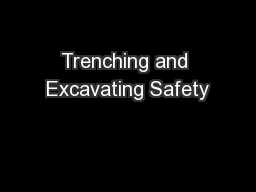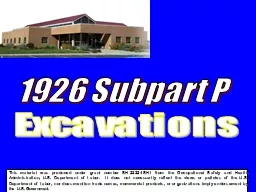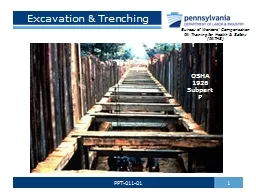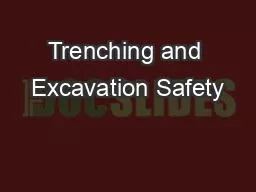PPT-Excavations and Trenching
Author : liane-varnes | Published Date : 2018-10-13
29 CFR 1926 Subpart P Presented by ETTA OSH Division 9198072875 Objectives In this course we will discuss the following ExcavationsTrenching Subpart P 1926650
Presentation Embed Code
Download Presentation
Download Presentation The PPT/PDF document "Excavations and Trenching" is the property of its rightful owner. Permission is granted to download and print the materials on this website for personal, non-commercial use only, and to display it on your personal computer provided you do not modify the materials and that you retain all copyright notices contained in the materials. By downloading content from our website, you accept the terms of this agreement.
Excavations and Trenching: Transcript
29 CFR 1926 Subpart P Presented by ETTA OSH Division 9198072875 Objectives In this course we will discuss the following ExcavationsTrenching Subpart P 1926650 Scope application and definitions applicable to this subpart. Unearthing institutional datasets to . strengthen and inform university practice. Clare Milsom, Martyn Stewart & Elena Zaitseva. Liverpool John . Moores. University. National Student Survey. Qualitative comments. WIRELESS READER INTERFACE Leading Innovators in Wireless Technology Virtually impossible to be compromisedWeather-tight enclosureEncoded Spread Spectrum Transmissions Interfaces for all access-control June. Workshop ‘Seeing beneath the soil’: Geophysics for beginners. 2-5pm. 26. th. June. . Workshop . ‘Strike a pose’: Archaeological photography for beginners 2-5pm. 28. th. June. Talk at TDC by Adrian Maldonado . Trenching and Excavation . Safety. About 400 workers die in the U.S. every year and about 6500 are seriously injured in trenching and excavation related accidents. If you are in a trench when a wall collapses you may get buried in soil very quickly. One cubic yard of dirt weighs approximately 2800 pounds, the same as a small pickup. . Excavating and . Lifting. Part 2. 3-4 DRAGLINES. Operation and Employment. Production Estimating. Job Management. Operation and Employment. The . dragline . is a very versatile machine that has the longest reach for digging and dumping of any member of the crane-shovel family. . Figure 1. Installation of bracing (a) using sheet piling; (b)soldier beams and lagging. Figure 2. Common types of bracing. Dimensional Analysis c = cohesionM LF = factor of safety-H = height or dept INTRODUCTION TO TRENCHING HAZARDSInfrastructure Health & Safety Association5110 Creekbank Road, Suite 400, Mississauga, Ontario L4W 0A1 Canada The contents contained in this publication are for genera Modelling. and. Network Design. Tim Glover. Chris Voudouris. Anthony Conway. Edward Tsang. Ali Rais Shaghaghi. Michael Kampouridis. Network Deployment. Given a new country/city. Where should phone/Internet cover be provided?. Asphyxiation. Each time a breath is exhaled the weight of the load restricts inhalation of the next breath. Slow suffocation usually follows unless rescue is immediate.. WHAT CAUSES DEATH?. SOIL WEIGHT. This material was produced under grant number . SH-22224-SH1 . from the Occupational Safety and Health Administration, U.S. Department of Labor. It does not necessarily reflect the views or policies of the U.S. Department of Labor, nor does mention trade names, commercial products, or organizations imply endorsement by the U.S. Government.. Excavation & Trenching 1 PPT-011-01 Bureau of Workers’ Compensation PA Training for Health & Safety (PATHS) OSHA 1926 Subpart P Topics Excavation and Trenching Hazards Trench collapses or cave-ins pose the greatest risk to workers146 lives When done safely trenching operations can reduce worker exposure to other potential hazards include falls falling loads hazardou In 1982, a backhoe operator working at what would become the new Windover Farms housing development in Titusville, Florida, uncovered a human skull. The bones of several other individuals soon emerged from the peat bog. It would be determined that the human remains uncovered at Windover were between 7,000 and 8,000 years old, making them 3,200 years older than King Tutankhamen and 2,000 years older than the Great Pyramids of Egypt. This was just the beginning of an archaeological adventure that continues today.“Windover is truly a unique site that continues to astonish. Dr. Wentz does a wonderful job of telling the two stories of Windover. One is the story of the people who lived in the area and are buried in the pond. The other story introduces you to the amazing people and circumstances which made the excavation possible. From its discovery by a backhoe operator and a concerned and interested landowner to the crew who worked on the project, Wentz effectively captures the stories of a fascinating archaeological discovery.” Charting precisely the progress of shoe fashions between the 12th and 15th centuries this is another must have for costume designers, archaeologists and historians.
Download Document
Here is the link to download the presentation.
"Excavations and Trenching"The content belongs to its owner. You may download and print it for personal use, without modification, and keep all copyright notices. By downloading, you agree to these terms.
Related Documents

